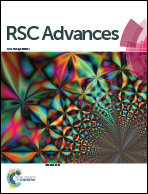Novel bipolar fluorescent polymers bearing N+![[double bond, length as m-dash]](https://www.rsc.org/images/entities/char_e001.gif) P–O− resonance structures for fluorescent–phosphorescent (F–P) hybrid white polymer light-emitting diodes (WPLEDs)†
P–O− resonance structures for fluorescent–phosphorescent (F–P) hybrid white polymer light-emitting diodes (WPLEDs)†
Abstract
Two novel fluorescent polymers PPOPAF and PPOCzF, with N+![[double bond, length as m-dash]](https://www.rsc.org/images/entities/char_e001.gif) P–O− resonance structures inserted into the fluorene-alt-carbazole based backbone, were developed as blue emitters and hosts for an orange-red phosphor to realize fluorescent–phosphorescent (F–P) hybrid white polymer light-emitting diodes (WPLEDs). The polymers exhibit proper HOMO/LUMO energy levels, good thermal stability and high triplet energy (ET) levels. Devices using PPOPAF and PPOCzF as single emissive layers show deep-blue emission with CIE coordinates of (0.16, 0.10) and (0.17, 0.10), respectively. Moreover, in hybrid white devices, doping with various concentrations of iridium(III) bis(4-phenylthieno[3,2-c]pyridinato-N,C2) acetylacetonate (PO-01) (0.1%, 0.2%, 0.5 wt%), the PPOCzF-based devices give a significant improvement than that of PPOPAF. While the doping concentration is 0.1 wt%, a nearly standard white emission (CIE: 0.35, 0.33) was achieved. The maximum CE, PE, EQE of PPOCzF-based devices is 4.4 cd A−1, 1.1 lm W−1, and 1.7%, respectively.
P–O− resonance structures inserted into the fluorene-alt-carbazole based backbone, were developed as blue emitters and hosts for an orange-red phosphor to realize fluorescent–phosphorescent (F–P) hybrid white polymer light-emitting diodes (WPLEDs). The polymers exhibit proper HOMO/LUMO energy levels, good thermal stability and high triplet energy (ET) levels. Devices using PPOPAF and PPOCzF as single emissive layers show deep-blue emission with CIE coordinates of (0.16, 0.10) and (0.17, 0.10), respectively. Moreover, in hybrid white devices, doping with various concentrations of iridium(III) bis(4-phenylthieno[3,2-c]pyridinato-N,C2) acetylacetonate (PO-01) (0.1%, 0.2%, 0.5 wt%), the PPOCzF-based devices give a significant improvement than that of PPOPAF. While the doping concentration is 0.1 wt%, a nearly standard white emission (CIE: 0.35, 0.33) was achieved. The maximum CE, PE, EQE of PPOCzF-based devices is 4.4 cd A−1, 1.1 lm W−1, and 1.7%, respectively.
![Graphical abstract: Novel bipolar fluorescent polymers bearing N+ [[double bond, length as m-dash]] P–O− resonance structures for fluorescent–phosphorescent (F–P) hybrid white polymer light-emitting diodes (WPLEDs)](/en/Image/Get?imageInfo.ImageType=GA&imageInfo.ImageIdentifier.ManuscriptID=C6RA05264A&imageInfo.ImageIdentifier.Year=2016)

 Please wait while we load your content...
Please wait while we load your content...
![[double bond, length as m-dash]](https://www.rsc.org/images/entities/h2_char_e001.gif) P–O− resonance structures for fluorescent–phosphorescent (F–P) hybrid white polymer light-emitting diodes (WPLEDs)
P–O− resonance structures for fluorescent–phosphorescent (F–P) hybrid white polymer light-emitting diodes (WPLEDs)